Miss. Delicious #85 : The Chang'an Food Gallery - The most immersive and authentic Chinese food experience ever!
Dear Steemit friends :
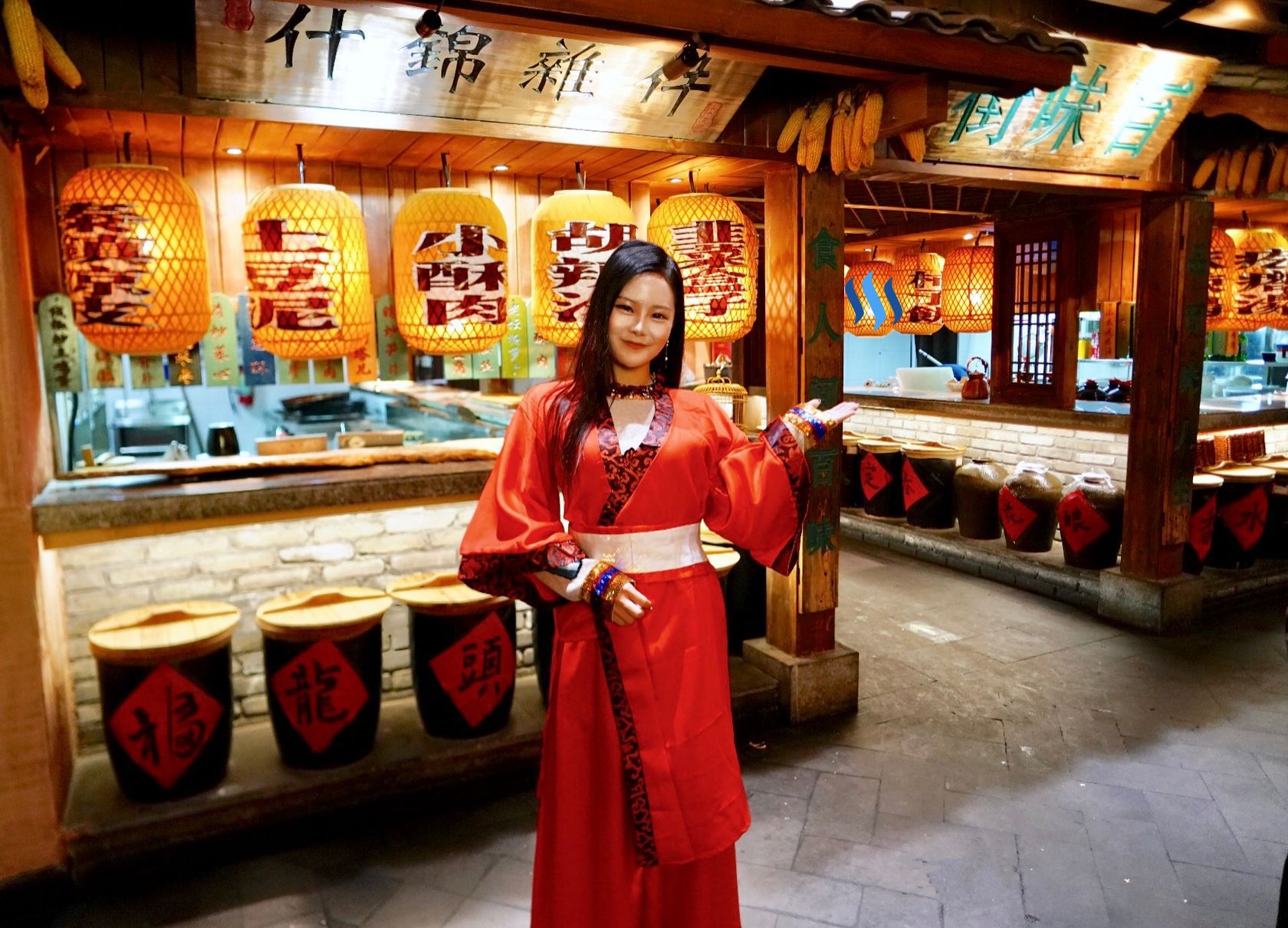
In the words of the late James Beard, "Food is our common ground, a universal experience."
Today, Miss. Delicious takes a trip back in time, to a time where Xi'an was better known as Chang'an, and for 10 dynasties, served as the capital city of all of China. Today's restaurant of choice is more than a place for gourmand's, it is also a place for gathering and entertainment. Indeed, this style of open air restaurant would have been a common place in old Chang'an.
Today, restaurants like this are few and far between, mostly surviving as novelties, reminding us of the historic food culture and restaurant customs.
The restaurant we're visiting today is called Chang'an Da Pai Dang, which translated means Chang'an food stall. In-case you were wondering, Chang'an, means "Perpetual Peace" and is named as such because of it's preference by Emperors to be the capital of China for 10 dynasties. Curiously, the restaurant has a quite different English name - The food gallery Xi'an, certainly placing more emphasis on the food whilst perhaps missing out on the equally important setting.
Let's begin our journey!
The restaurant is located inside a shopping district to the north of the central walled city of Xi'an. It is becoming a lot more common in China for restaurants to be located in large shopping centres and not operating on independent premises. This is mainly due to the inner city redevelopment, knocking down low rise buildings, and replacing with tall high rise tower blocks.
The Food Gallery Xi'an, is actually a restaurant chain specialising in recreating not only historical foods, but also historical atmospheres based on their location. In Xi'an, the obvious is the great Chang'an capital, but elsewhere, there would be distinctively different styles depicting different local customs.
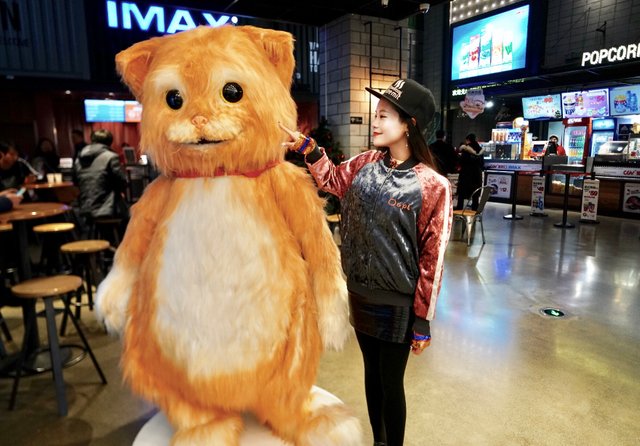
Walking past the IMAX also inside the shopping centre, we finally arrive at the main entrance of the Food Gallery. Perhaps by chance, the giant cat figure stood beside the restaurant acting as the Chinese / Japanese lucky cat, bringing good custom.
Outside, the restaurant had a long queue of hungry people waiting for their number to be called out. No doubt, this restaurant has become a major drawing factor for the shopping centre because it is by far the most popular restaurant and also the only one with queues.
The entrance was a magnificent sight, it was filled with all the relics of a traditional Chang'an restaurant, from the traditional clay roof tiles, to the large overhanging restaurant plaque and auspicious lanterns hanging either side. Historically, this kind of restaurant would be multi floored with a courtyard centre. The floors above would have tables overlooking the centre making the whole restaurant hollow from bottom to the top.
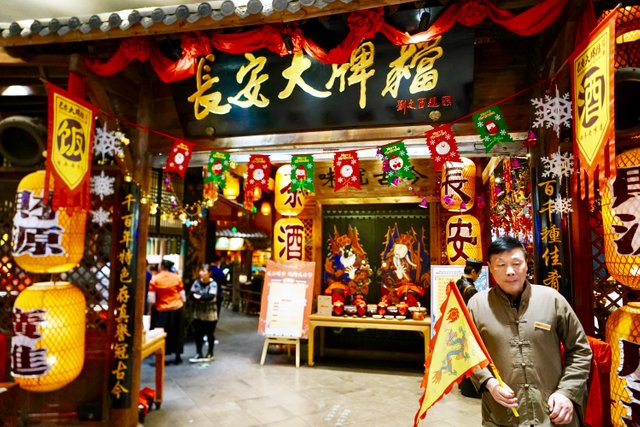
Snacks were offered to people as they waited. This practice is becoming a norm in China as the food service industry becomes more and more competitive. Consumer driven growth has helped the restaurant service industry thrive and every little bit extra restaurants can offer will build long term customer relationships and that means long term business. Good for everybody right?

Historically speaking, there would be many stalls outside the buildings on the streets, with many crafts(wo)men, who would sell their creations. This kind of market bartering persisted right up to the last dynasty. In line with this tradition, there was a girl who was selling her handmade play dough figures. I thought they were made with icing and were edible!

Historically, restaurants served as both a place to dine, but also a place to drink. Kind of like the modern day pub. In those day's, people use to drink fruit wines fermented in these large pots, though not as strong as modern day alcohol, they would drink these kinds of wines throughout the day like a soft drink.
The ones placed on the table are for sale to take home.
In the background, we can see the hero and the demon on the large knocking doors. They are the antagonist and protagonist for many Chinese fairy tales as well as the main characters in the live puppet shows later on.
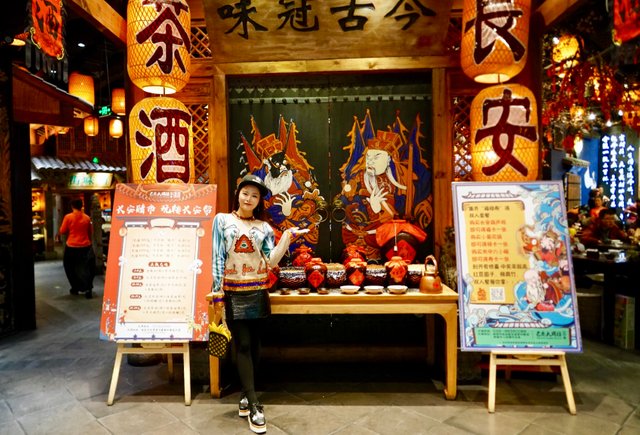
Like most Chinese restaurants, there are private dining rooms for larger parties of people.
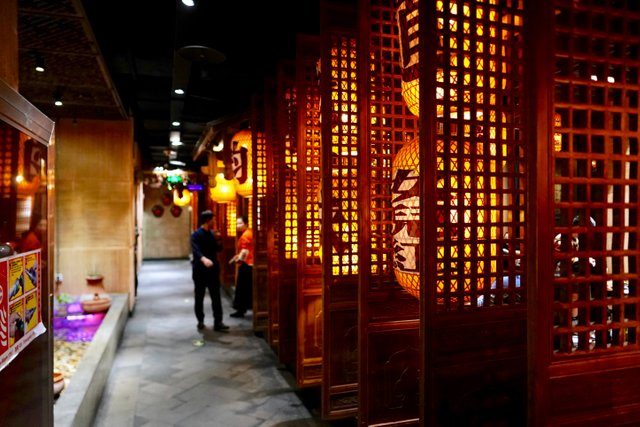
This is where the "snack" foods are prepared. It is common for restaurants to work with vendors on the street each selling different kinds of small snack foods. Contrary to what a lot of Chinese restaurants in the west suggest, people in Chang'an like to eat many varieties of food instead of dishes each with large portions. Thus, this "street" is called the 100 Taste Street, a street where you can expect to taste at least 100 different kinds of snacks.
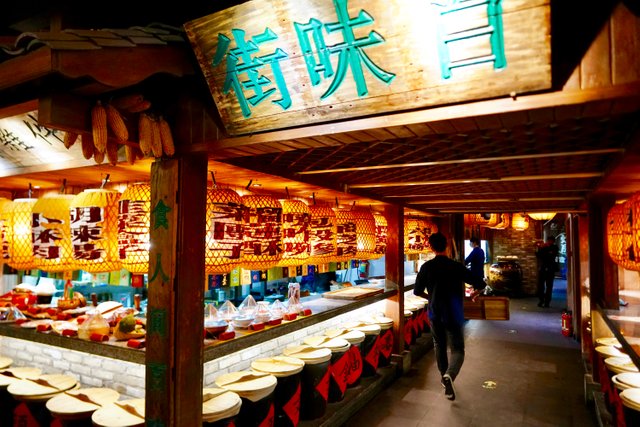
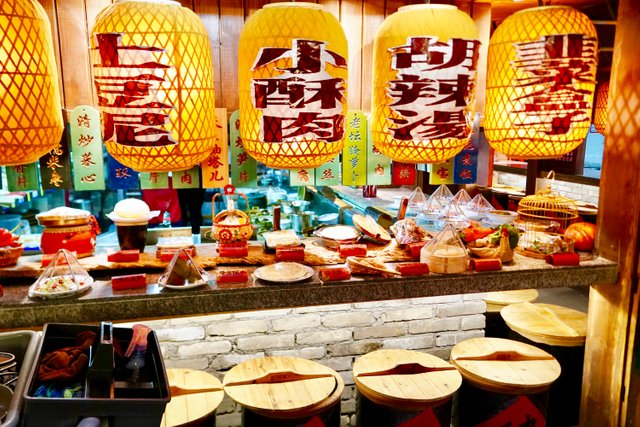
Restaurants like this one would simultaneously function as a place of gathering and socialising as well as a place to dine. The function of this little stall may come as a surprise to some people. It is the equivalent of a cash counter at the casino. The wooden tallies were used as "chips" when entering the casino, and then cashed out when leaving.
Nowadays, gambling with real money is illegal. But it doesn't prevent people from playing popular games like Mah-jong, a game equally popular in those days and frequently played after eating, over drinks.
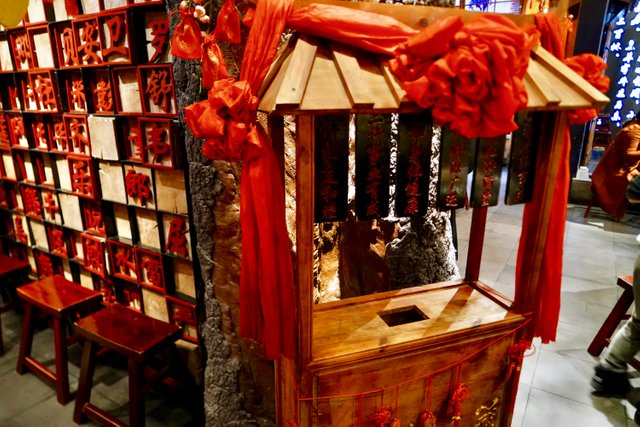
This part of the restaurant resembles a garden. Surrounding the raised platform are small ponds with real goldfish. And in the background, you can see the little houses which are used as the private dining rooms.

These are traditional Chinese silk paintings. Although these are modern replicas, silk paintings have an extensive history in China of over 2000 years. Much like the frenzied art collecting world of today, people in the ancient times like to collect works of art from famous painters as a sign of wealth and power. Each painting would be instantly recognisable and stand out to other collectors.
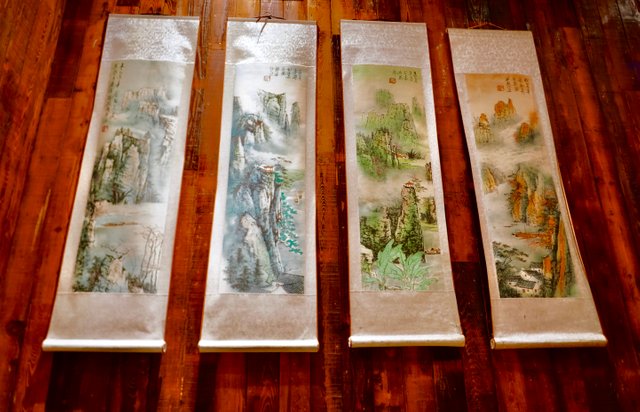
As I mentioned earlier, the restaurants of old would have several floors, all surrounding a main court yard. To get a table on the upper floor, you have to state your intention before you queue. I think it is definitely worth getting a seat on the upper level with a view of the stage.
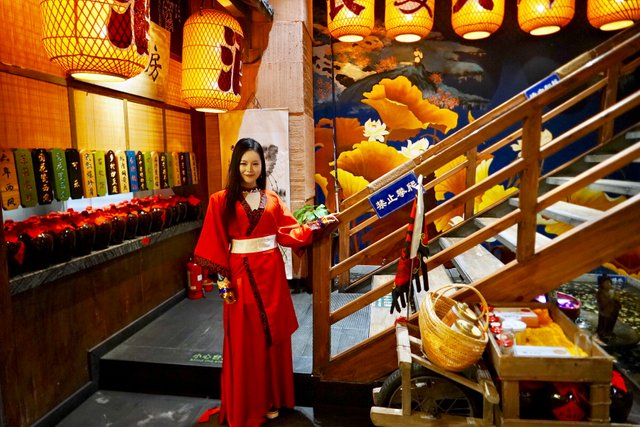
My view of the garden courtyard.
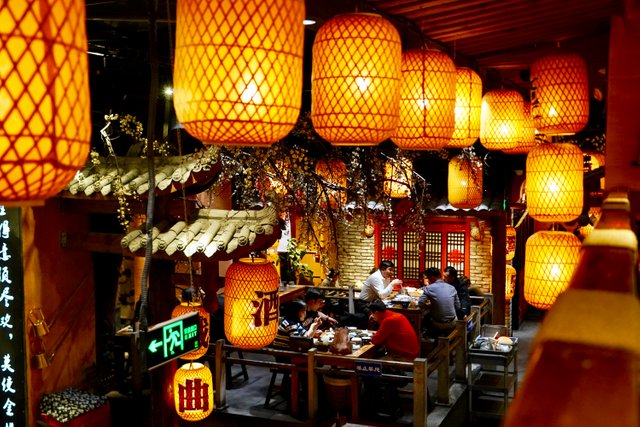
And the view of the main court yard.
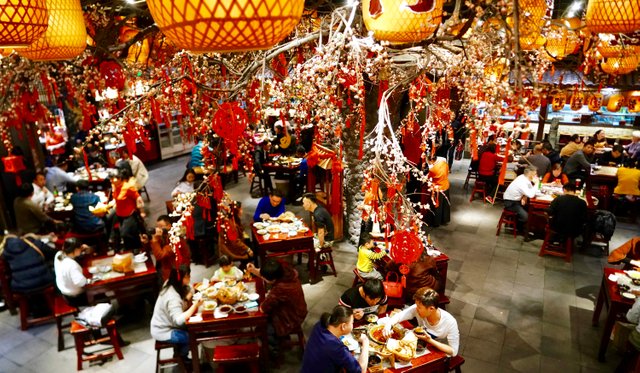
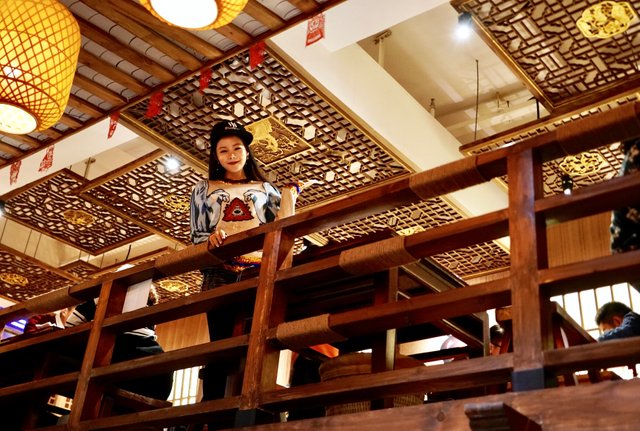
The Food Gallery
What would a restaurant be without it's food? The restaurant is appropriately named The Food Gallery for a reason, and below, you shall see exactly why!
First up, we have the fried calligraphy brush with berry dip. This is a wonderful piece of art. The deep fried dough and meat form the tip of the brush and is dipped into the berry sauce much like the process of ink brush calligraphy or ink-brush painting. In terms of the taste, it is crispy, slightly sweet, and very addictive!
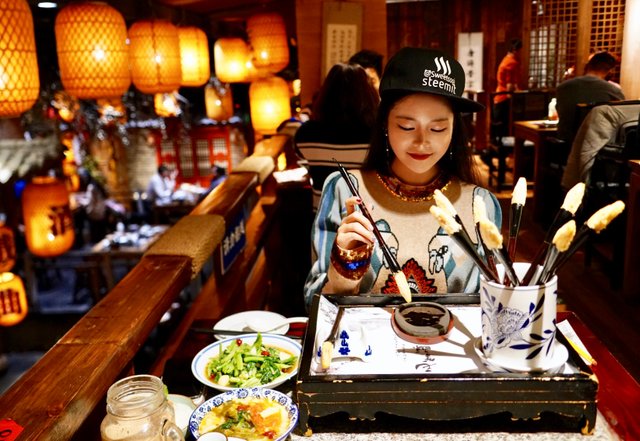
Growing up in China, we are all required to learn ink-brush calligraphy. It is considered a form of art. The talented ones can go on to make a career out of calligraphy as beautiful characters express more than just the meaning of the words, but also the character of the painter.

This ice cream is served not as a dessert, but rather as a starter. The base is a fermented rice alcohol porridge, which dilutes the sweetness of the ice cream some what. It is a curious combination but a very sweet one!
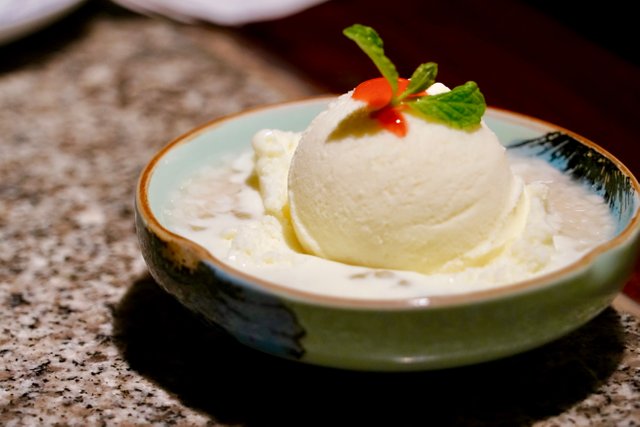
The Sour Vegetable Fish broth noodles. The strange name comes from the fact that the noodles are shaped a bit like fish. It is a strange mixture of sweet chilli sauce and sour vegetables, on top of that, it is served cold. Another starter to get the appetite going!

Garlic fried Choi Sum. A staple dish in many parts of China. This is a dish frequently seen in Hong Kong but is actually quite standard across all styles of Chinese food. I always make sure to have atleast one serving of green vegetables, and this is it!
The key to telling the difference between a good fried vegetable dish and not, is the oil. This one was cooked by flash boiling and then quickly stir fried with a hint of oyster sauce, soy sauce and garlic. Most of the nutritional value is retained because of the method of cooking and thus, it tastes a whole lot fresher!
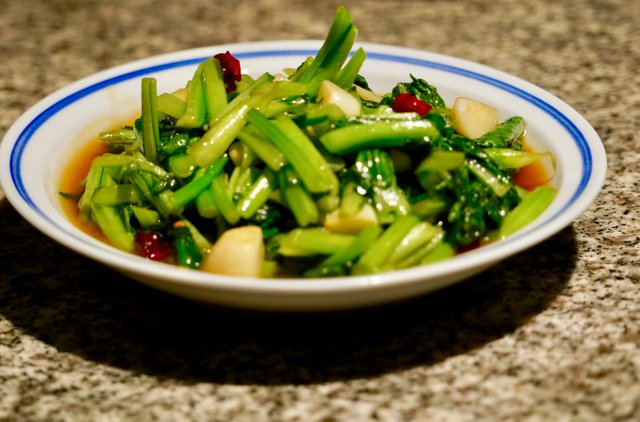
Earlier, we had a glance at one of the tally stalls where people could cash in and out of their gambling money. Here we have a set of Mah-jong jelly pieces complete with a dice and edible 100 CNY paper note!
Though I'm sure in the past people did not make mah-jong jelly, this sweet dish adds so much to the atmosphere. We can no longer gamble in China, but there is nothing stopping us from playing mah-jong with food right??
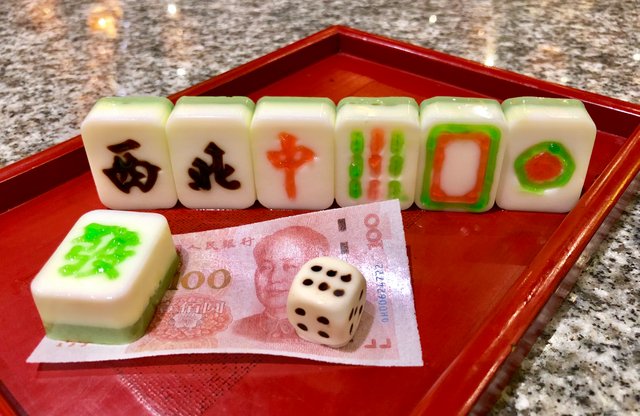
Chang'an Barbecued Pork Meat with Wrap.
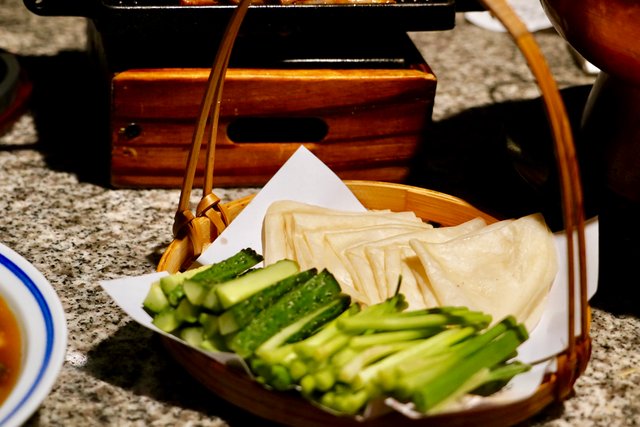
Much like the Peking Duck you will find in Beijing, the Chang'an version uses Pork neck meat instead of duck, and omits the usual hoisin sauce in favour of pre-marinated pork. Dressed with spring onion and cucumber, you wrap the meat the same way you would Peking duck. It's not as sweet as the Peking duck, but where it lacks in sweetness, it makes up for in with a flavourful piquant blend.
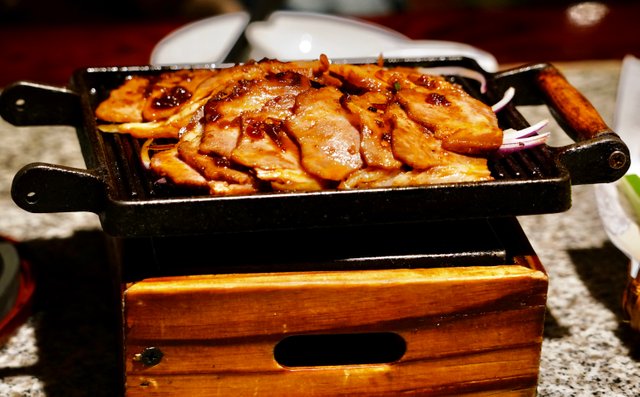
Six mouthfuls of flavour.
Literally translating from the Chinese name of this dish. The Shaann'xi people love noodles, and this comes from a long tradition and habit of eating noodles as the main dish in place of rice. The standard amount to eat is 6 bowls of noodles per person. It may seem like a lot, but the sweet and sour taste along with the single mouthful of noodles in each bowl make it much more palatable than it looks.
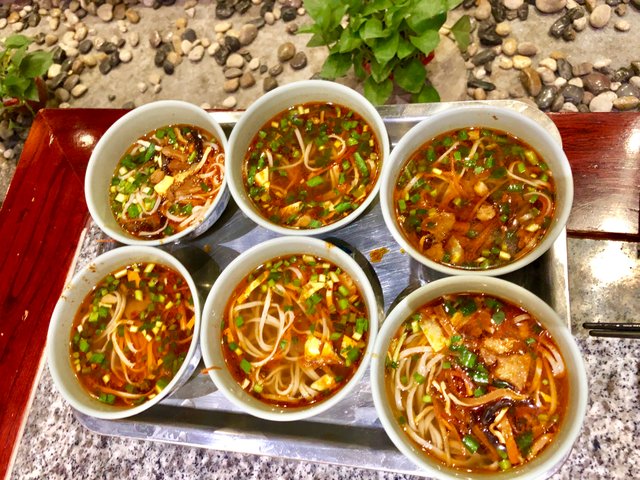
Sweet and Sour Prawns.
One of my favourite dishes cooked in the traditional Chang'an way. You'll notice the prawns still have their shell. For westerners, the shell is considered a nuisance as it requires your hands getting dirty. However, Chinese people like to eat things that present a challenge. Somehow, the meat just tastes much better when considerable effort is made to get it. Alternatively, some people eat the prawn whole with the shell. It's sufficiently soft and has no real harm.
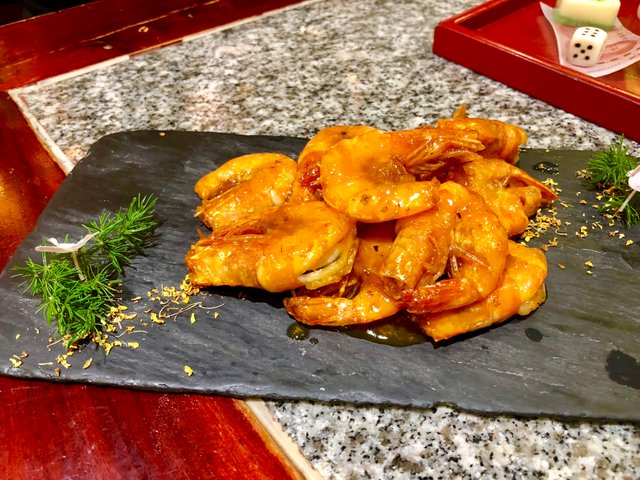
Sweet Vinegar Cabbage
Another staple dish in the Chinese repertoire, the starchy texture of the sauce is made with cornstarch flour. The effective of the sweet vinegar combined with the cornstarch is a thick sauce which is viscous. Again, it is best eaten as an appetizer.

Beef Brisket Hot Pot
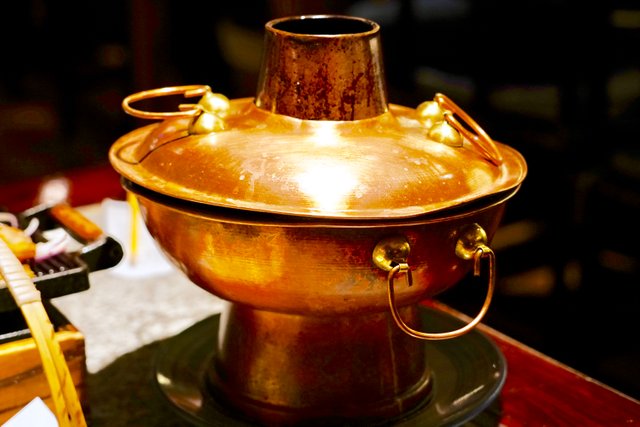
This strange kiln oven looking contraption is the Chang'an instrument used to eat hot pot. The funnel at the top is to allow the smoke from the burning wood/coal at the bottom escape upwards. Nowadays, a combustible solid fuel lighter, likely methanol is burned instead. Once sufficient heat is reached, you can open up the lid and enjoy the soft beef brisket and white cabbage.
In the winter, this is a particularly common dish because of the warmth the hot pot provides. It is a surprisingly light dish with very plain taste. You'll find the usual vermicelli, mushrooms, fish balls and bean curd in the soup too. The serving size is perfect as a complementary dish to others. This is in contrast to other places which feature hot pot as the main dish.
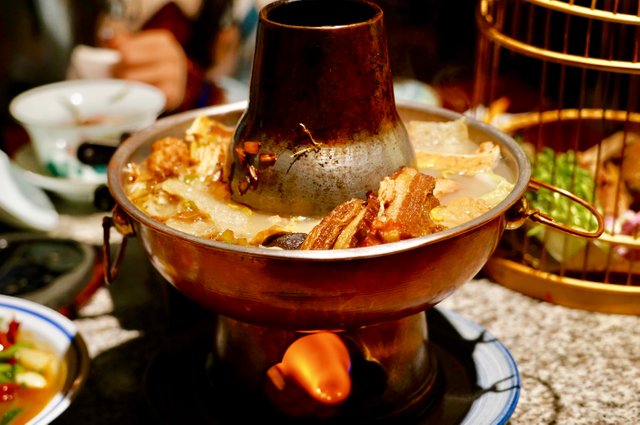
Tofu Brain is the literal translation for this dish and I suspect it is named as such because of how similar it looks to the brain. Sometimes it is called bean curd flower which I think is a more appropriate name. Sometimes people get too concerned with the names of Chinese foods and are put off by that.
This almost tastes a bit like a porridge with the tofu cooked till it's soft enough to "chew" with your tongue. That is probably the point as the majority of the taste will come from the rich spices added into the mix. The only part of the concoction with some solid texture are the bits of fried bread and dough.
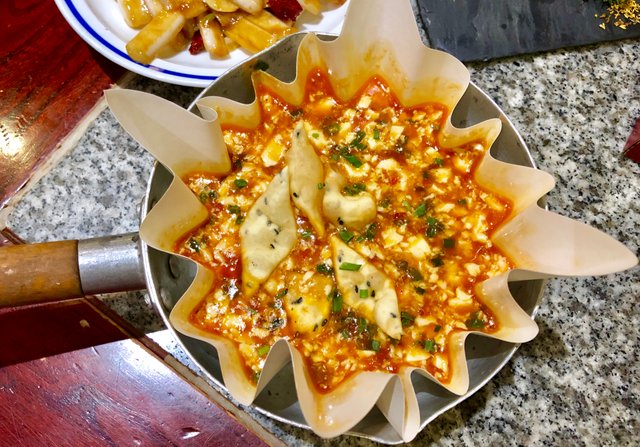
Beef Tripe and twisted dough stick skewers
We've seen Hui Min Night Market in Xi'an and it's famous barbecued meat skewers. This is a different style of of skewer which is also very popular. Many people might be put off by the Beef Tripe, it is after-all the lining of the stomach, but in traditional Chinese gourmet, it is considered a very nutritious dish.
In the old times, food was not very plentiful and the Chinese found ways to eat nearly every part of the animal, leaving very little to waste.
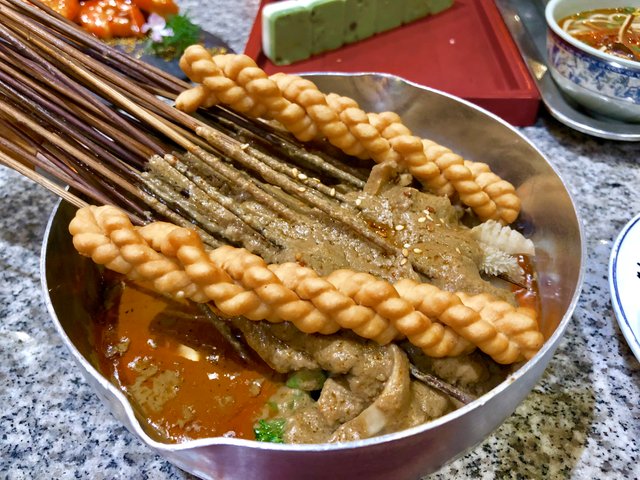
Long mouth copper pot
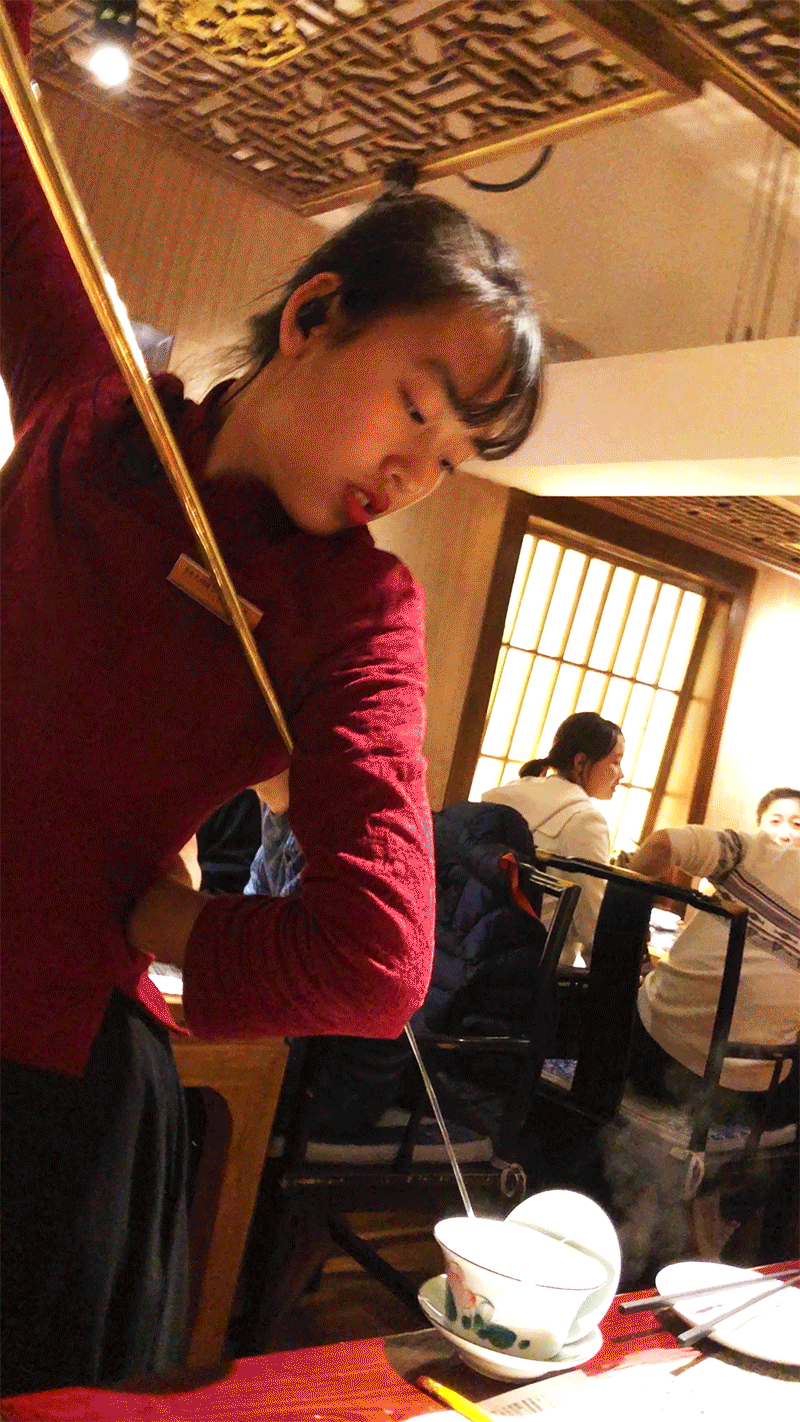
A unique piece of copper ware to China, this Long Mouth Copper Pot is used to serve tea. It has an excessively long "mouth" which requires the waitress to hold the pot really high to pour the tea.
You might be wondering what is the purpose of having such a extreme design for a tea pot? It is to allow the water to cool as it travels from the pot all the way down the mouth and out. The large surface area from covering such a distance allows considerable heat dissipation to take place.
Regardless of whether this actually makes much of a difference, isn't it interesting to see it in action?
Chang'an six ingredient tea.
Six seems to be a common number with Chang'an food. Before, we had the six mouthful of flavour noodles. And here, we have the six ingredient tea consisting of : Jujube, Chrysanthemum, Goji berry, Longan Fruit, Ginger and lastly Tea leaves.
This combination sounds like something a practitioner of Chinese medicine would use, and indeed it is supposed to be effective for restoring health and vitality. The correct way to drink it is to use the lid to block the berries, fruits and leaves whilst sipping the tea. I also show this in the video.
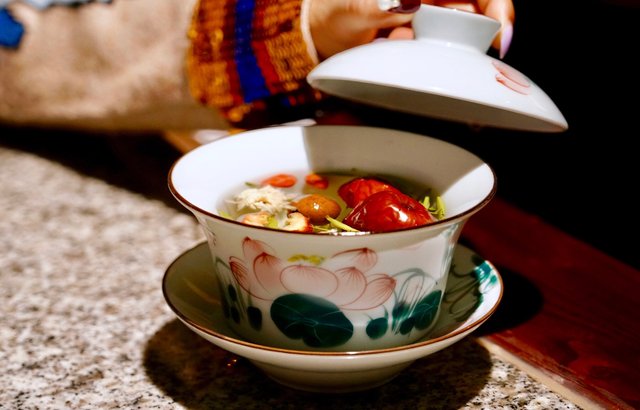
Fruit Juice Cocktail and Whole grain porridge.
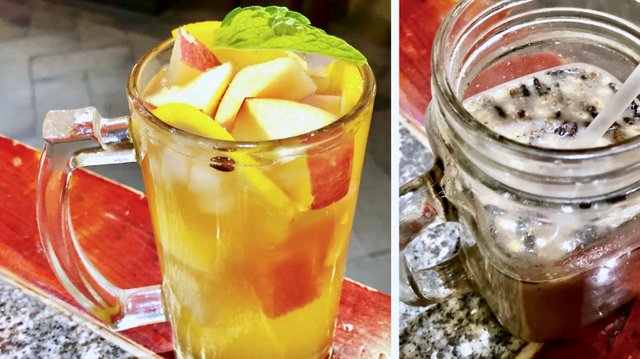
Spit roasted Bird in a Cage.
This is a Cantonese inspired dish as the Chicken is prepared in a spit roasted style which is familiar to people who eat Cantonese siu mei food. The chicken is organic and raised in the Qinling mountains.
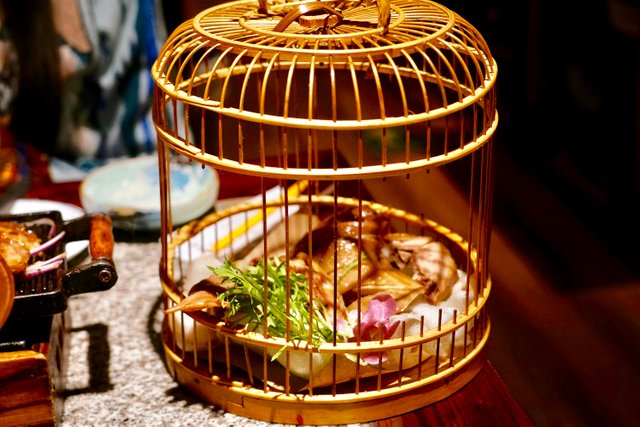
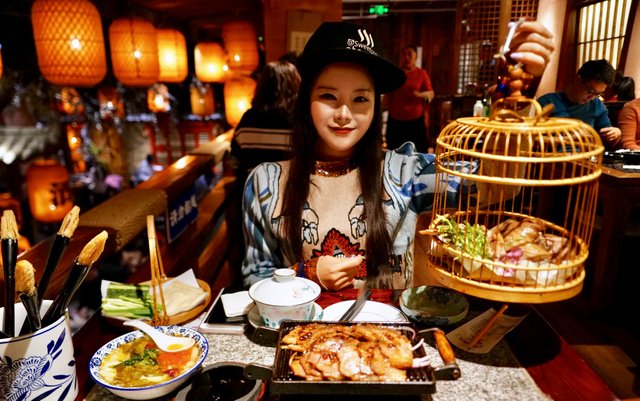

One of the highlights of the restaurant are the traditional Chinese performances on stage. Here, you can expect to see shadow play puppetry and Chinese folk theatre music. Both adding to the already brimming Chinese atmosphere of the restaurant.
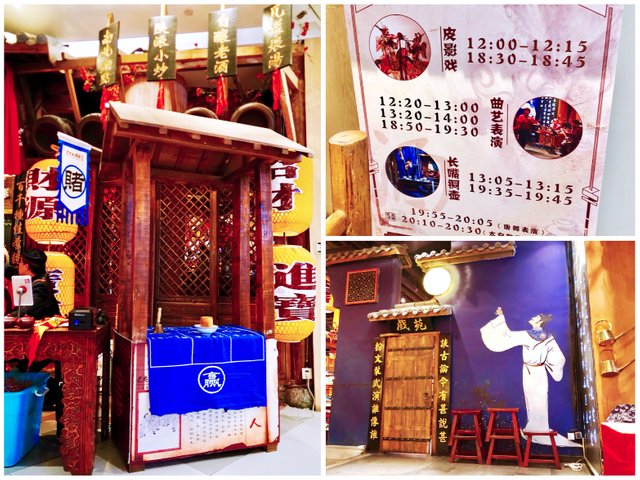
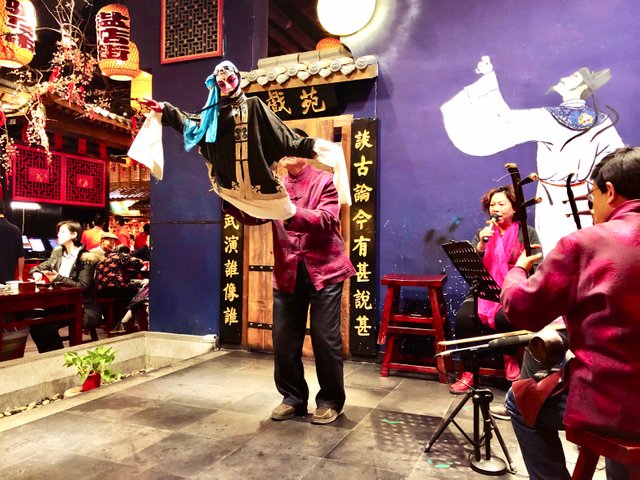
Make sure you check out the video!
And that wraps up our visit to The Food Gallery Xi'an. It is perhaps one of the most complete Chinese dining experience you can find in Shaan'xi, though there are plenty of restaurants featuring the classic Chang'an food palette, few offer the genuine Chang'an atmosphere in terms of the interior design, entertainment and even food presentation.
Listening to the folk music and watching the puppet shows whilst eating is exactly how the people of Chang'an went about their food gatherings, and now we have the opportunity to relive that exact experience. It is rare for a restaurant to tick all the boxes, but this is certainly one that does so for me.
I would highly recommend this restaurant if you intend to visit Xi'an, it is by far the most authentic Chang'an experience you will find. Visiting the restaurant is truly like taking a walk into a chapter of history.
As always, please upvote the post if you liked it, make sure you follow for more food and travel logs, and leave a comment to let me know what you think!
在短短的一周之内,我们一起去马尔代夫钓了水中的精灵护士鲨,又来到秦岭山下邂逅了国宝朱鹮的倩影,今天我想和大家一起穿越到古代的长安大牌档客栈酒楼,只要一顿饭,带诸位客官们一口气吃遍陕西古今的著名小吃。长安大牌档是一家西安连锁的精品小吃店,这里汇聚了本地各具特色的小吃,开业短短几年就迅速成为了西安美食的标签,是游客们探索和尝鲜的最好去处,也是很多当地人怀旧,重温熟悉又亲切老味道的温馨港湾。
在很早之前,我就在网络对这家餐厅有所研究,简直就像发现了新大陆,充满了新鲜有趣的亮点。所以一来到西安,我就直奔主题,迅速打开了探索美食的战斗模式。来到餐厅门口,就好像来到了人气旅游点,慕名而来的食客已经拍成了一条长长的队伍,千里迢迢来到西安的游客,谁又忍心错过这一站式美食体验呢?整个餐厅的装修精心又别致,门口悬挂了一排金黄色灯笼耀眼极了,挂在屋顶的复古菜牌上写着陕西小吃的名称。可以让等位的客人率先预习下陕西美食的名字。
最有趣的要数门口帮忙叫号的工作人员,他们穿着古代的服装,拿着旗子,用纯正的陕西口音叫着号。叫号人的桌子前面,还提供给等位客人免费的四宫格小吃,和休闲小游戏,例如大门右边的小摊档提供银两押宝的游戏,发银票押大小,消磨等位的时间。大门的另一边还有古装美女捏面人儿的展示台,我站在边上看了好久,这五颜六色的面团,在手艺人手中像变魔术一样,瞬间变成栩栩如生的小动物,如果有时间,真想和她学学。门口的精彩活动让等位的时间变得一点也不寂寞。
走进餐厅,门口的屏风前摆着一排酒缸,有贵妃醉,桂花酿和女儿红,还有各式五谷杂娘,迅速把我带入了古代民间的氛围之中。餐厅里面的空间非常宽敞,分为两层,是典型的大排档布局,也很像古代的客栈。让我一下子回想起多年前的火爆电视剧《武林外传》里的场景,还有闫妮可爱的陕西话。放眼望去,餐厅的仿古装修极具特色和风味,小桥流水的环境非常舒适。餐厅的一侧是一条长长的百味美食街,小摊档实际是开放式的操作台,店小二们不停的传菜,热闹极了。账房作为餐厅的收银台,柜台由一个硕大的算盘做成,太有创意了。墙上的字画让整个餐厅的文化气息非常浓厚,一排包厢每一个都是很有趣的名字,望长安、酒逢知己、金榜题名和洞房花烛夜。店小二把我引到二楼的位子坐下,四角桌子,长条凳子,可以体验最原汁原味的当地民俗特色。从餐厅的二楼,可以看到整个餐厅的全景。餐厅中的一棵大树,树枝上挂着吉祥的红色剪纸。接下来就到了西安美食经验速成的时刻,这里菜的新颖程度好像完全更新了我的美食数据库。
首先上来的是毛笔酥,以文化古城为誉的长安,美食也透露着文房四宝的气息。一套笔墨纸砚的工具台被店小二端上桌,我承认这是我第一次吃到这样有新意的小吃,把造型独特的酥饼作为毛笔头放进真正的毛笔杆中,这样精美的设计还真是颇费心思。这个毛笔酥完全可以以假乱真。最有趣的是,蘸毛笔酥的酱汁做成了墨汁的样子,整体的物件精致的让我有些不舍得吃了。这些狼毫毛笔,笔锋似剑,殊不知吃起来有着刚刚出炉般的温热和酥脆,还有秘制馅料包裹其中,好像入口即化,蘸蘸“墨汁"味道更香甜。接下来是醪糟冰淇淋,这样的搭配也是超乎想象的,原来把醪糟酒酿,软糯的西米,和幸福甜蜜的香草冰激淋结合是这样的美味,酸酸甜甜的撞击口感,让我吃的停不下来。
浆水鱼鱼,它是陕西的著名传统小吃,用淀粉做成鱼的样子,在我看起来倒是很像小蝌蚪。放入切碎的榨菜,辣椒和番茄,吃起来酸辣爽口,非常开胃。蒜仔炒菜心,吃起来非常清爽。接下来是麻将十三幺,木桌上的麻将牌造型逼真,惟妙惟肖,淀粉做成的小甜品,还带着可以吃的小筛子和人民币百元大钞,同样可爱到不忍心吃了。这家餐厅的菜品设计和摆盘只能用惊艳来形容,每次端出一盘新菜都让人眼前一亮。这还不够,餐厅每晚都有不同的表演,皮影戏,秦腔和长嘴铜壶,甚至还有唐乐舞表演。边吃这样独具风味的美食,并有现场演绎的秦腔助兴,葬花吟的乐曲演奏和活灵活现的皮影戏艺术,让每一位在场的食客都看呆了,包括我啦。这里真的有太多美食值得品味了,真想长出十个胃,一一品尝一遍。接下来是长安烤肉配饼,猪颈肉经过小火慢烤,香气扑鼻。配上篮子里的薄饼,黄瓜和葱绿,完全可以体会到秦人独有的生活情趣。
西府一口香,一份六碗,一碗一口,面条非常劲道,酸酸的汤味道真香。桂花虾甜甜酸酸的,吃了不仅开胃也让人体会到开心的甜蜜。金边白菜吃起来脆脆的。接下来是小菊花锅,一开始我以为是火锅,掀开盖子发现算是一种创意冒菜,有点烩三鲜的既视感。店小二介绍说这道佳肴是陕西宫廷的名菜,铜锅在灯光下闪着金光。锅里的料相当丰富,有香菇珍菌,红肉丸子,用高汤以木炭火炖煮,香飘十里。炒豆腐脑味道很浓。豆皮涮牛肚锅,大概是市井间最常见的美食,爽滑的牛肚遇上劲道的豆皮,加上香浓的芝麻酱,完全无法抵抗的诱惑。饮料的部分我点了长安六合茶,店小二绪水的功夫,让人惊讶,那么长的水壶可以做到滴水不漏真是一门技术。金橘茉莉水果茶和老西安糙米甜浆也很香醇。最后是筒子鸡,这也是陕西名菜,食材来自秦岭深山中的农家放养鸡,经过卤煮和侵泡,让整道菜色香味俱佳,回味无穷。今天的陕西特色美食之旅就到这里啦,之后还有更多的美食故事在等着我们。
very nice post :)
Love the high quality of this comment and the rewards is getting! Lol
I dont get it, does it mean a whale voted for his comment and that gave him 70 SBD right away? Maybe it was the post author who did it, considering it got 2019 votes only one of her upvotes would be worth a lot.
When i saw the post it had only one upvote. It was a new account literally i think it was the first comment. So i am guessing it is a whale that have created a "ghost account" to bank. 🤔 i would like to know what is going on as well... lol
Haha well making 75 X 3 for a comment can’t be that bad. I am having a not easy time to understand all the system what do you mean with “ghost account”? Like please tell me how a whale profits out of giving a random comment such a huge reward?
The whale makes another account called ghost account while having main account which has good reputation , steem powered,etc and then he comments from the ghost account to a certain post and the main account upvotes the reply from the ghost account = profit.
or dummy acct.
The real quality in this post is in the comments on the comments.
lol
Gooood
lol
That is a shocker for sure. I came to this post from a reference at another one. This is the first time I have seen this type of comment upvoting, although I have heard the rumors before.
Just put your head down and work, my friend Sergio. We can't worry about the people doing this and hopefully will not do it ourselves, given the chance. So sad to see.
Yeah it is really sad that people do this. Specially if are people that are already doing a lot of profit here. But why create ghost accounts. They are just afraid of getting flagged in their main account i guess. So this is a way to bank without hurting their reputation and "good name" but it is kind if sad.
Oh, I did not realize this either. It just looks bad for the first comment on such a high profile post. My author friends would call "scam" if they saw this when thinking of posting here.
True. But hopefully people will stop doing that
Yes my friend , she is the explorer !! She enjoy her travels we enjoy her stories !!
When you got almost a million dollars worth of steem power of course your rewards will be great :)
WTF is wrong with people xD I would shave my legs and be called grandpa to have a comment that high.
thanks for resteem.
How did you make money with this comment?
Once again, you provided a very interesting adventure. Thanks!
I must say I am always in awe of your wonderful posts, complete with extremely well written text, magnificent richly colored images, and even videos complete with beautiful location relevant music.
Let us not forget about the best part of your posts, which is, of course, YOU!
I can see that you are an extremely intelligent, cultured, and elegant young lady. Of course, one need not mention the obvious, the fact that you are also quite gorgeous!
Thank you for sharing your culinary and cultural experiences with us. It is my sincere hope and dream that I may be able to visit faraway lands again in the very near future.
Until then, I will be quite content to live vicariously through you!
Great job as always.
Hey @contentking, how's your content creation now?
My business has been so busy lately that I haven't had any extra time to post much here, unfortunately. Maybe after the new year I will be able to find the time to write a little more. Thanks for asking :)
YW! Me I have long forsaken my Medium blog already due to this all crypto and ICO phenomenon going on. It's very addictive! The moment you enter into the crypto currency arena you will lose interest in blogging outside the Steem platform.
WTF is going on with SBD now? This is going to the galaxy if they don't print additional coins. This is totally insane!
I agree, crypto is very exciting. It seems like there isn't a day that goes by that something very big happens.
My girlfriend broke up with me because she said I no longer have time with her. She even added that my face will eventually look like a Bitcoin. lmao
You may have forgotten to buy her some additional items with the wealth you are making out of it? My wife was like that but the moment she saw the first time I made 100% out of an investment she just let me be.
Looks like a lot of fun. Keep having fun... :)
will do funnyman, thanks!
Ohhh i dont know if i have been missing your posts or if you have been gone. Eheheh but it was a pleasure to know that you are doing great. And now i am so hungry because of this. Eheheh love the kimono outfit. Aweskme. Kisses :)
ah dear sergio, i've been around! I've just not been able to post everyday like I used to, but I hope to post one every other day or so, so stay on the look out! :)
i love your photos..
nice dear @sweetsssj
Yes, Amazing dishes that I never seen ever. All photos are good. I like the most Apparel of @sweetssj. I like this post.
@sweetsssj
美丽的东西
你非常好,我喜欢很多
Don't you think this all here is like a dream? When we imagine the lifes of our grandparents?
I agree.. it is very much like a journey back into the past, but even more long ago than the time of our grand parents!
Eheheh so it is my fault I have been missing your posts. Need to go to your profile and check what I have been missing out. 😘
the food here is really half the experience, you get so much more out of it than just a meal! nice thanks.
I'm looooving you outfit!! And the main color of the luck and prosperity <3 I'm loving China and those foods. Is amaizing how many detalis a plate can have, like the one of the cage and the way they serve Tea! :O Totally astonishing. Thanks for sharing
Wish I could go there soon, hope steemit helps me out. I train Wushu and Wing Chun so It's looks like a dream for me to travel :(
Oh gosh for a person like you with a deep appreciation of Chinese culture, i'm sure this would interest you a whole lot! You have got to make it a goal to visit China some day, it's such an exciting place to be, with so much history and culture, and yet it's really making a push to modernise at the same time.
I love to read your post, but this one is my favorite one. Yes you're rigth I have to make it my goal!! maybe my goal for 2018!! Would love to see more about china trough you, what you share is in some way like a teletransportation for us the readers.
Looking forward to chat in a near future, travel safe and enjoy <3
Fantastic article, and images! I enjoyed your video also. You deserve every dollar you make on this post. I enjoyed it very much. Thank you for putting so much effort into this.
hi rip-youtube, thank you for the compliments, very encouraging and i'm very thankful you watched the video. I keep watching back and just enjoying the performances, you don't get to see them very often at all anymore!
You're welcome, and you have a new follower. Yes, I very much enjoy, and respect the "established" cultures, and Chinese is one! As an American, I don't have the long history. (I love your hat by the way. lol)
ahh haha my hat has been quite popular! It's a shame the new logo is different now.. I have to update it for this upcoming year!
Again you have lead us along life's bounty so offered my China's grand past. Your mastery of history and custom is unmatched by anyone else on steemit, and why I , like everyone is always waiting for your next post. Thank you so much for enriching life with your travels and adventures.
johnny, every time you say something like, I feel so humbled because it's coming from someone with so much background and experience. Thank you for giving me this boost of encouragement, it really does give me so much motivation to try improve and deliver more good content.
So miss Delicious is finally here and i was waiting for this part from the day you told me that you visited a very traditional Chinese restaurant and going to make a post about that,and my wait is finally over so this is the place that you are talking about few days ago on steemit.chat,well i think The Food Gallery Xi'an is the most traditional Chinese restaurant that i ever seen and the way of serving the food is quite impressive and traditional at the same time,in this post i really like your work on capturing the details and beauty of this place and by the way you are looking so pretty in that traditional Chinese dresse almost like a doll 😇 so now comes to the food,well these all food items are very rich looking and i really like the Long mouth copper pot and Spit roasted Bird in a Cage. These two things are very unique,and i really like the video clip in which you cover almost every thing about this place,you know what last night one of my friends joined steemit and he was just asking me to tell him some name of good steemers and i just told him about your account and also say him that this is one of my good friend on steemit and also a very good Blogger then he ask me why is she getting this much upvotes on her post,what is so special about her post,then i just simply open and show him one of your recent posts and trust me right after seeing and reading your post my friend just said me that this girl is really deserves these upvotes and Support because he really likes the way of your presentation in your posts and that's why most of the steemit users know you and appreciate you sandia.😇😇 And post is really very very beautiful and tasty too,now iam waiting for your upcoming special post,all the best dear.😇👍👍
Hi shiva, thank you for coming along and supporting, it's always lovely to share these experiences with you because I know you're so receptive to them. Especially since we talked about it so much, I thought you might be eagerly waiting for it!
I'm also very thankful for your friend for giving me such a good review, i'm sure we'll be acquainted one day as well. Catch up soon! :)
Sure sandia iam waiting for that day haha,all the best for the upcoming special post and iam really like to see you new skills in that post😉
I am not tired of seeing your interesting post and images. You are a very example of where I want my life to go. Thank you!
javybar, thank you. I appreciate your support :)